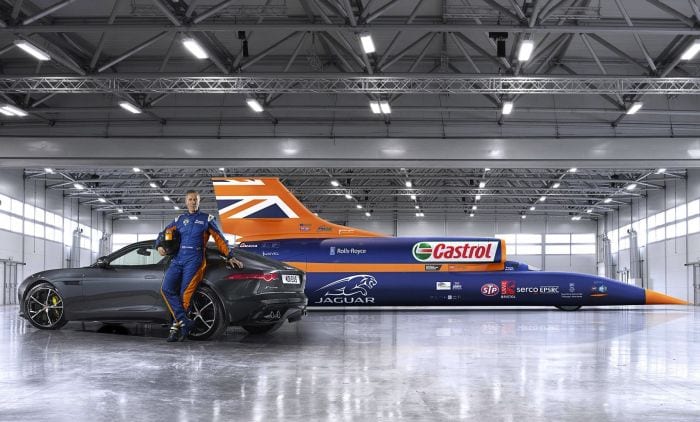A land vehicle powered by three different types of engines in the works, and its engineers aim for it to exceed 1,000 MPH. That is well above the speed of sound, which is 761 MPH at sea level. The three engines are a Rolls-Royce turbofan, a Jaguar V8 engine to power the fuel pump, and a rocket.

Image obtained with thanks from CarThrottle.
Another way to look at that extreme speed is: It is slightly over a quarter-mile per second. Imagine flying through an entire race track every second. Aircrafts have already blown past the speed of sound at velocities exceeding 2,000 MPH, but land vehicles are very inefficient and hard to control at such high speeds.
This may be why the designers constructed this with some plane-like characteristics, including a tail fin, a turbofan for the generation of thrust, and a pointy, tubular chassis.
This vehicle used to be equipped with a Cosworth 2.4 litre F1 engine which powered its fuel pump, but now the fuel pump will be powered by a 542 BHP Jaguar V8 engine to help it surpass its own land speed record of 763 MPH. BHP means brake horsepower. This is the engine’s horsepower output excluding losses caused by the transmission and drivetrain.
In case you were wondering, the 5.0 litre, 542 BHP Jaguar V8 engine is just for the fuel pump, not the propulsion system. The propulsion system is 77,500 BHP!
Why Doesn’t The Bloodhound SSC Have An Electric Fuel Pump
Due to the unfortunate rules of drag, travelling at speeds exceeding 1,000 MPH results in such poor fuel efficiency that a ridiculous quantity of fuel is required (40 litres of rocket fuel per second) for every measly mile that this vehicle travels, so it would require a colossal fuel pump (which would require an extremely large alternator to power it).
I’m not saying that a V8 fuel pump is best, but i’m just throwing the reason I mentioned out there as a possibility. I could be wrong.
For the moment, the team is going to try to attain a speed of 800 MPH next year with Andy Green as the driver, and 1,000 MPH in 2016.
Source: CarThrottle.








